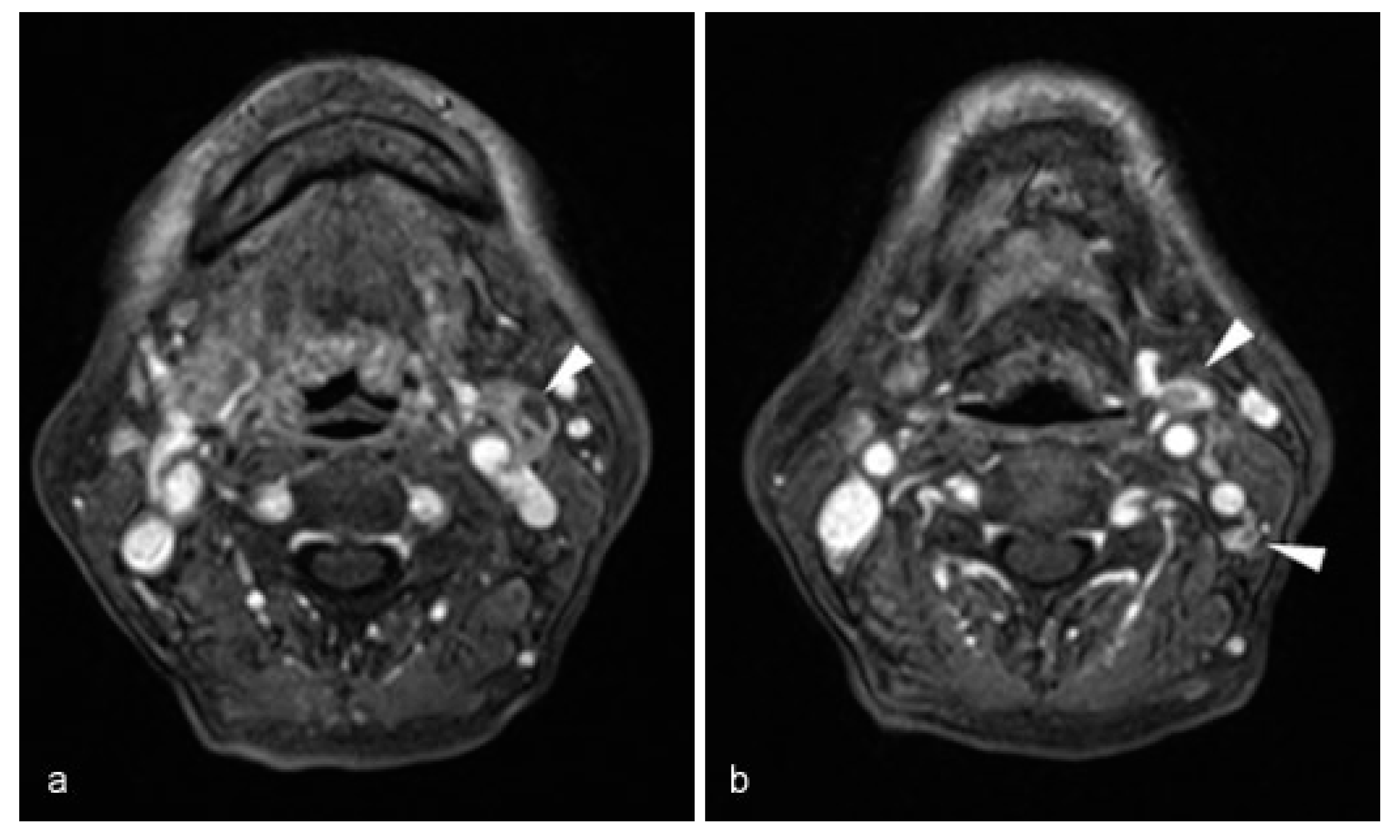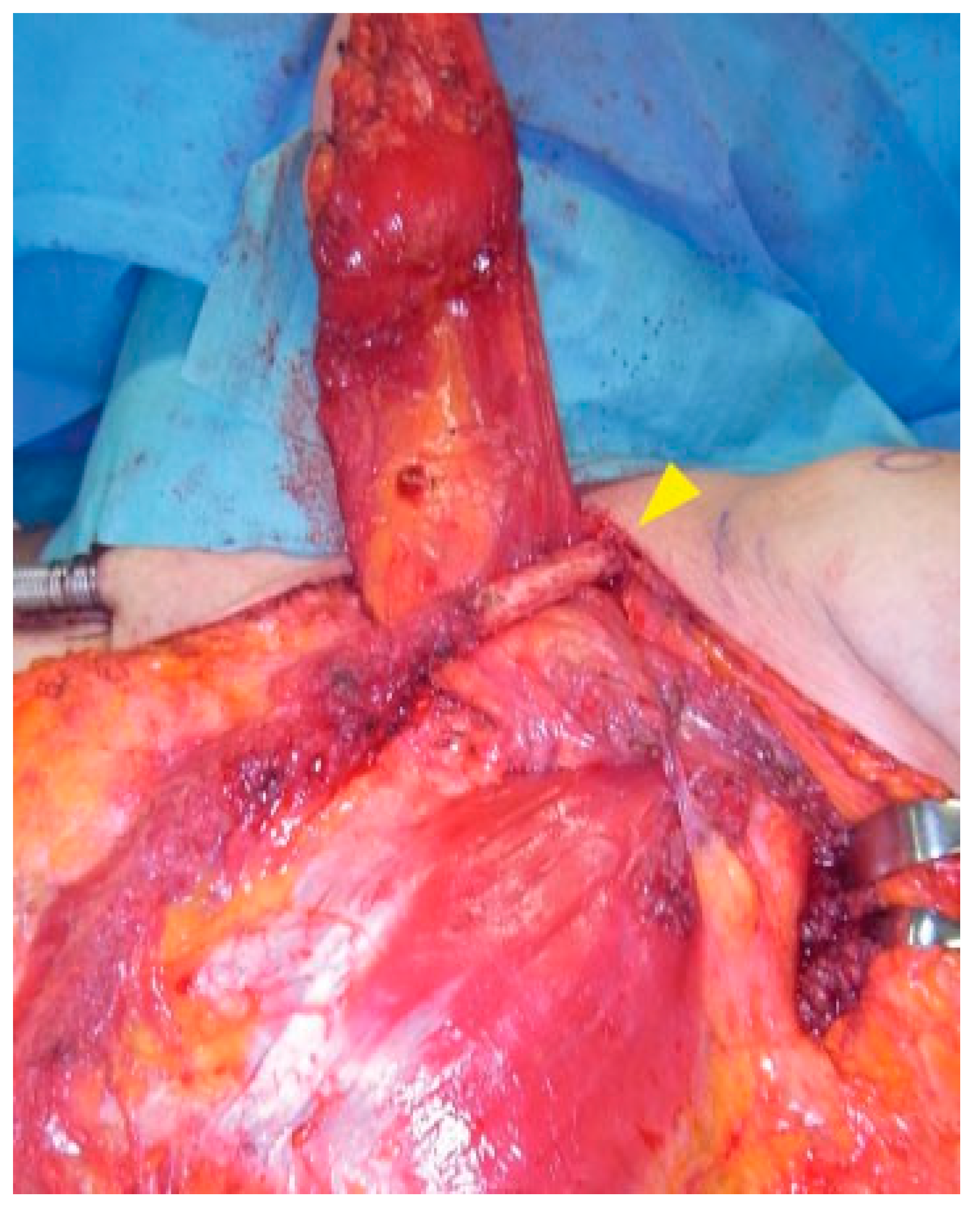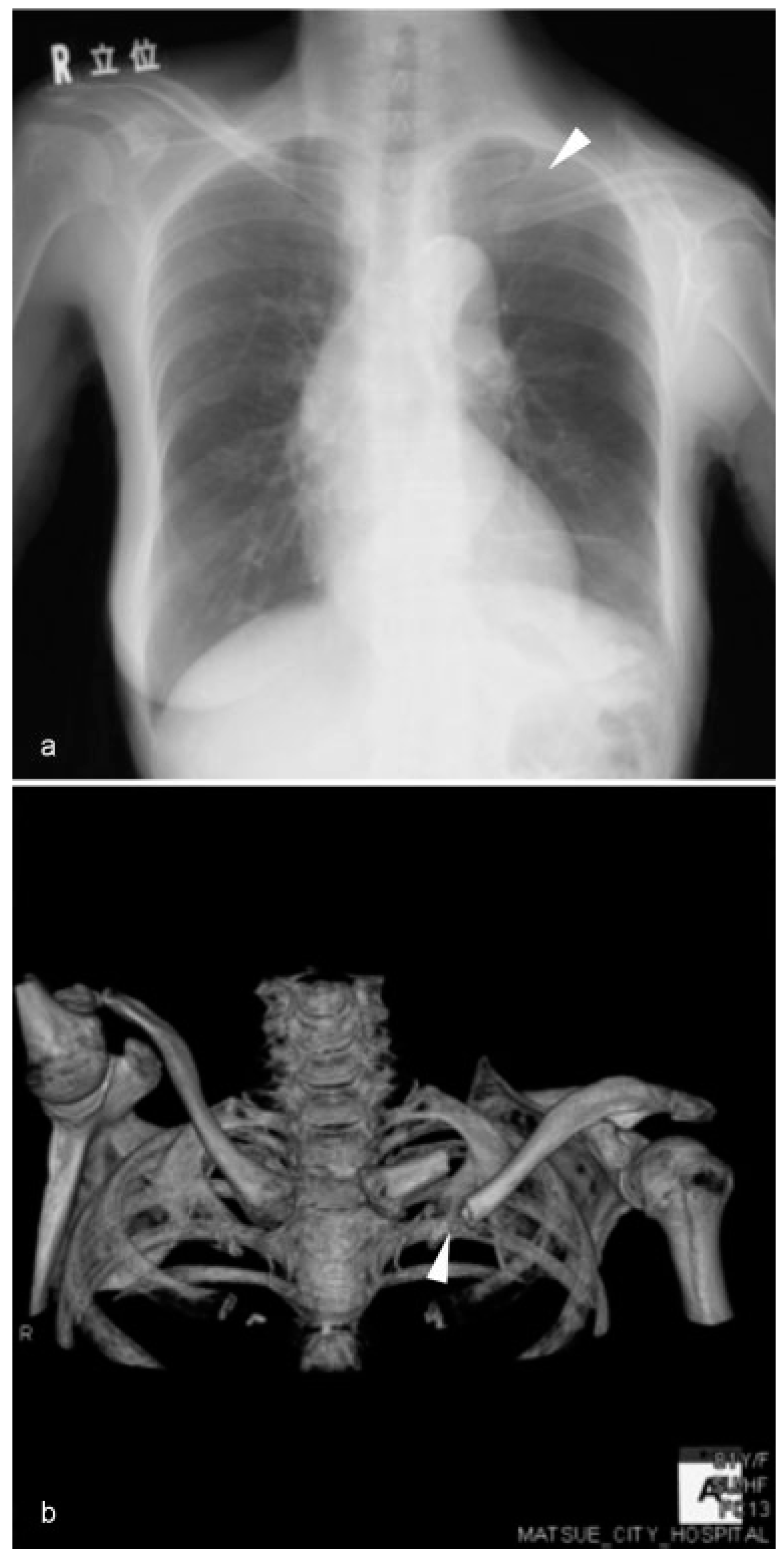Fracture of the Clavicle Following Radical Neck Dissection and Reconstruction Using Pectoralis Major Myocutaneous Flap Accompanied by Postoperative Radiotherapy
Abstract
:Case Report




Discussion
Conclusions
References
- Lörz, M.; Bettinger, R.; Desloovere, C.; Leppek, R. Clavicular fractures after radical neck dissection [in German]. HNO 1991, 39, 147–150. [Google Scholar]
- Strauss, M.; Bushey, M.J.; Chung, C.; Baum, S. Fracture of the clavicle following radical neck dissection and postoperative radiotherapy: A case report and review of the literature. Laryngoscope 1982, 92, 1304–1307. [Google Scholar] [CrossRef]
- Milenović, A.; Virag, M.; Uglesić, V.; Aljinović-Ratković, N. The pectoralis major flap in head and neck reconstruction: First 500 patients. J Craniomaxillofac Surg 2006, 34, 340–343. [Google Scholar] [PubMed]
- Vartanian, J.G.; Carvalho, A.L.; Carvalho, S.M.; Mizobe, L.; Magrin, J.; Kowalski, L.P. Pectoralis major and other myofascial/myocutaneous flaps in head and neck cancer reconstruction: Experience with 437 cases at a single institution. Head Neck 2004, 26, 1018–1023. [Google Scholar] [CrossRef] [PubMed]
- Koh, Y.W.; Choi, E.C.; Lim, Y.C.; Lee, S.W. Fracture of the clavicle following the island type of pectoralis major myocutaneous flap for reconstruction of head and neck defect. Eur Arch Otorhinolaryngol 2007, 264, 675–679. [Google Scholar] [CrossRef] [PubMed]
- Sobin, L.H.; Gospodarowicz, M.K.; Wittekind, C. International Union Against Cancer (UICC) TNM Classification of Malignant Tumours, 7th ed.; Wiley-Liss: New York, 2010; pp. 25–29. [Google Scholar]
- Kiyokawa, K.; Tai, Y.; Tanabe, H.Y.; et al. A method that preserves circulation during preparation of the pectoralis major myocutaneous flap in head and neck reconstruction. Plast Reconstr Surg 1998, 102, 2336–2345. [Google Scholar] [CrossRef]
- Kanno, T.; Nariai, Y.; Tatsumi, H.; Karino, M.; Yoshino, A.; Sekine, J. A modified pectoralis major myocutaneous flap technique with improved vascular supply and an extended rotation arc for oral defects: A case report. Oncol Lett 2015, 10, 2739–2742. [Google Scholar] [CrossRef]
- Ord, R.A.; Langdon, J.D. Stress fracture of the clavicle. A rare late complication of radical neck dissection. J Maxillofac Surg 1986, 14, 281–284. [Google Scholar] [CrossRef]
- Cantlon, G.E.; Gluckman, J.L. Sternoclavicular joint hypertrophy following radical neck dissection. Head Neck Surg 1983, 5, 218–221. [Google Scholar] [CrossRef]
- Fini-Storchi, O.; Lo Russo, D.; Agostini, V. ‘Pseudotumors’ of the clavicle subsequent to radical neck dissection. J Laryngol Otol 1985, 99, 73–83. [Google Scholar] [CrossRef]
- Halfpenny, W.; Goodger, N. Early fracture of clavicle following neck dissection. J Laryngol Otol 2000, 114, 714–715. [Google Scholar]
- Temesvari, A.; Vandor, F. Complications after cervical dissections [in German]. Chirurg 1954, 25, 437–443. [Google Scholar]
- Kanda, T.; Kitajima, K.; Saito, M.; Otsuki, N.; Nibu, K.; Sugimura, K. Insufficiency fracture of the clavicle after neck dissection: Imaging features. Jpn J Radiol 2014, 32, 172–178. [Google Scholar] [PubMed]
- Bradley, P.J.; Ferlito, A.; Silver, C.E.; et al. Neck treatment and shoulder morbidity: Still a challenge. Head Neck 2011, 33, 1060–1067. [Google Scholar] [PubMed]
- Cummings, C.W.; First, R. Stress fracture of the clavicle after a radical neck dissection; Case report. Plast Reconstr Surg 1975, 55, 366–367. [Google Scholar] [PubMed]
- Gorman, J.B.; Stone, R.T.; Keats, T.E. Changes in the sternoclavicular joint following radical neck dissection. Am J Roentgenol Radium Ther Nucl Med 1971, 111, 584–587. [Google Scholar]
- Howland, W.J.; Loeffler, R.K.; Starchman, D.E.; Johnson, R.G. Postirradiation atrophic changes of bone and related complications. Radiology 1975, 117 (3 Pt 1), 677–685. [Google Scholar]
- Spar, I. Total claviculectomy for pathological fractures. Clin Orthop Relat Res 1977, 129, 236–237. [Google Scholar]
- Soo, K.C.; Strong, E.W.; Spiro, R.H.; Shah, J.P.; Nori, S.; Green, R.F. Innervation of the trapezius muscle by the intra-operative measurement of motor action potentials. Head Neck 1993, 15, 216–221. [Google Scholar] [CrossRef]
- Svenberg Lind, C.; Lundberg, B.; Hammarstedt Nordenvall, L.; Heiwe, S.; Persson, J.K.; Hydman, J. Quantification of trapezius muscle innervation during neck dissections: Cervical plexus versus the spinal accessory nerve. Ann Otol Rhinol Laryngol 2015, 124, 881–885. [Google Scholar]
- Nori, S.; Soo, K.C.; Green, R.F.; Strong, E.W.; Miodownik, S. Utilization of intraoperative electroneurography to understand the innervation of the trapezius muscle. Muscle Nerve 1997, 20, 279–285. [Google Scholar] [PubMed]
- Gavid, M.; Mayaud, A.; Timochenko, A.; Asanau, A.; Prades, J.M. Topographical and functional anatomy of trapezius muscle innervation by spinal accessory nerve and C2 to C4 nerves of cervical plexus. Surg Radiol Anat 2016, 38, 917–922. [Google Scholar] [PubMed]
- Kim, J.H.; Choi, K.Y.; Lee, K.H.; Lee, D.J.; Park, B.J.; Rho, Y.S. Motor innervation of the trapezius muscle: Intraoperative motor conduction study during neck dissection. ORL J Otorhinolaryngol Relat Spec 2014, 76, 8–12. [Google Scholar]
- Pu, Y.M.; Tang, E.Y.; Yang, X.D. Trapezius muscle innervation from the spinal accessory nerve and branches of the cervical plexus. Int J Oral Maxillofac Surg 2008, 37, 567–572. [Google Scholar] [PubMed]
© 2017 by the author. The Author(s) 2017.
Share and Cite
Nariai, Y.; Odawara, S.; Ichiyama, T.; Akutsu, J.-i.; Kanno, T.; Sekine, J. Fracture of the Clavicle Following Radical Neck Dissection and Reconstruction Using Pectoralis Major Myocutaneous Flap Accompanied by Postoperative Radiotherapy. Craniomaxillofac. Trauma Reconstr. 2018, 11, 138-141. https://doi.org/10.1055/s-0037-1600903
Nariai Y, Odawara S, Ichiyama T, Akutsu J-i, Kanno T, Sekine J. Fracture of the Clavicle Following Radical Neck Dissection and Reconstruction Using Pectoralis Major Myocutaneous Flap Accompanied by Postoperative Radiotherapy. Craniomaxillofacial Trauma & Reconstruction. 2018; 11(2):138-141. https://doi.org/10.1055/s-0037-1600903
Chicago/Turabian StyleNariai, Yoshiki, Sho Odawara, Tomoko Ichiyama, Jun-ichi Akutsu, Takahiro Kanno, and Joji Sekine. 2018. "Fracture of the Clavicle Following Radical Neck Dissection and Reconstruction Using Pectoralis Major Myocutaneous Flap Accompanied by Postoperative Radiotherapy" Craniomaxillofacial Trauma & Reconstruction 11, no. 2: 138-141. https://doi.org/10.1055/s-0037-1600903
APA StyleNariai, Y., Odawara, S., Ichiyama, T., Akutsu, J.-i., Kanno, T., & Sekine, J. (2018). Fracture of the Clavicle Following Radical Neck Dissection and Reconstruction Using Pectoralis Major Myocutaneous Flap Accompanied by Postoperative Radiotherapy. Craniomaxillofacial Trauma & Reconstruction, 11(2), 138-141. https://doi.org/10.1055/s-0037-1600903


